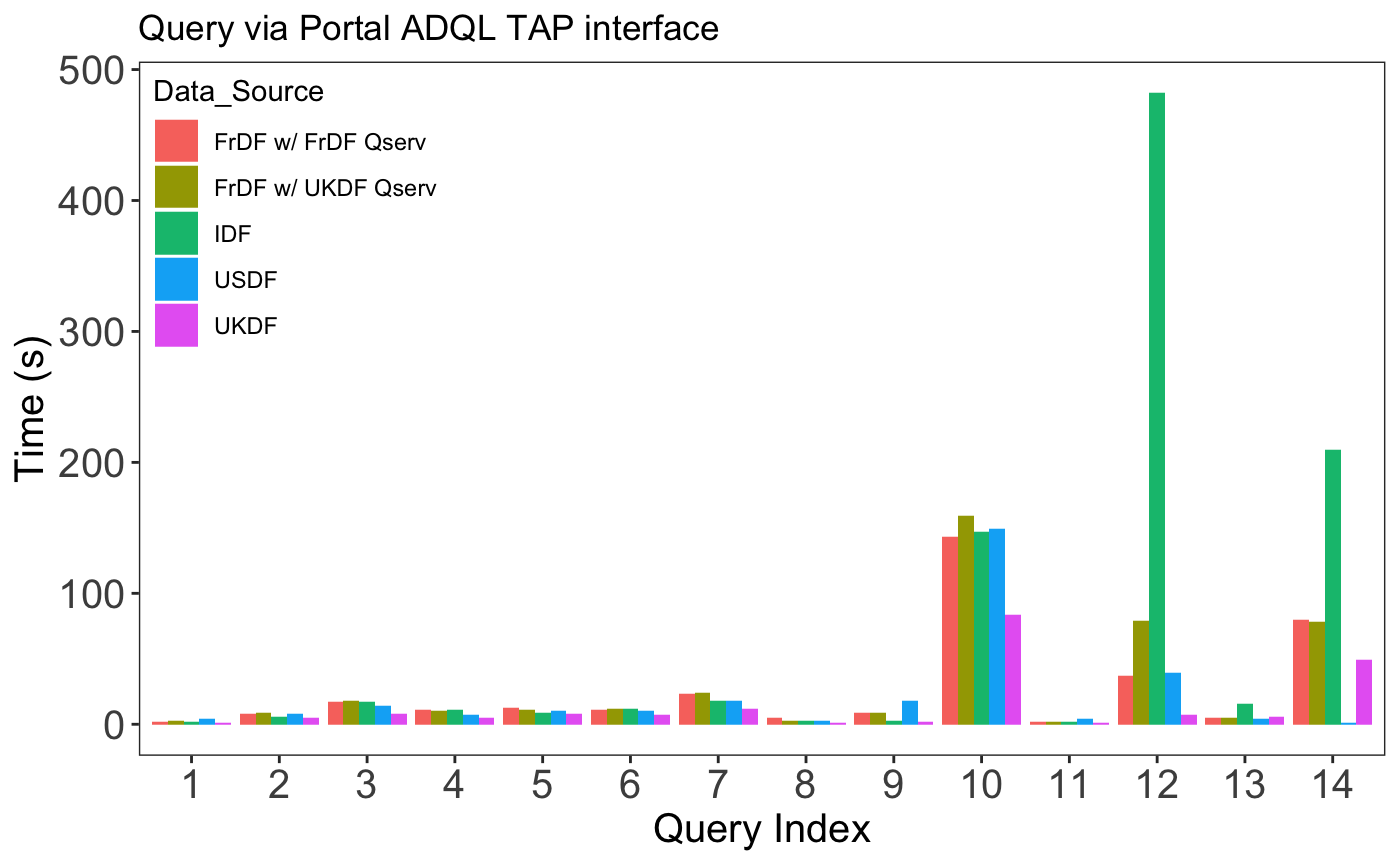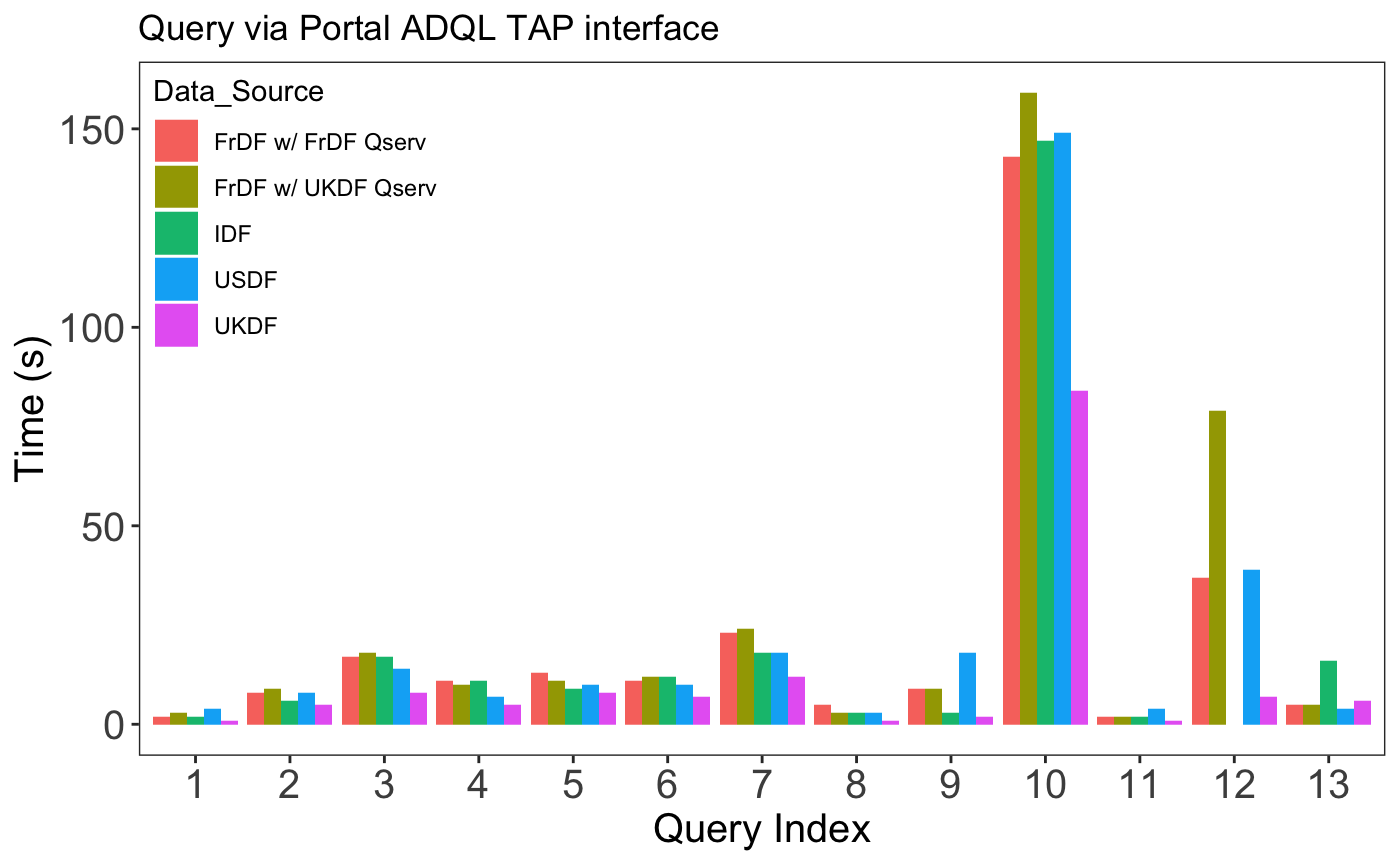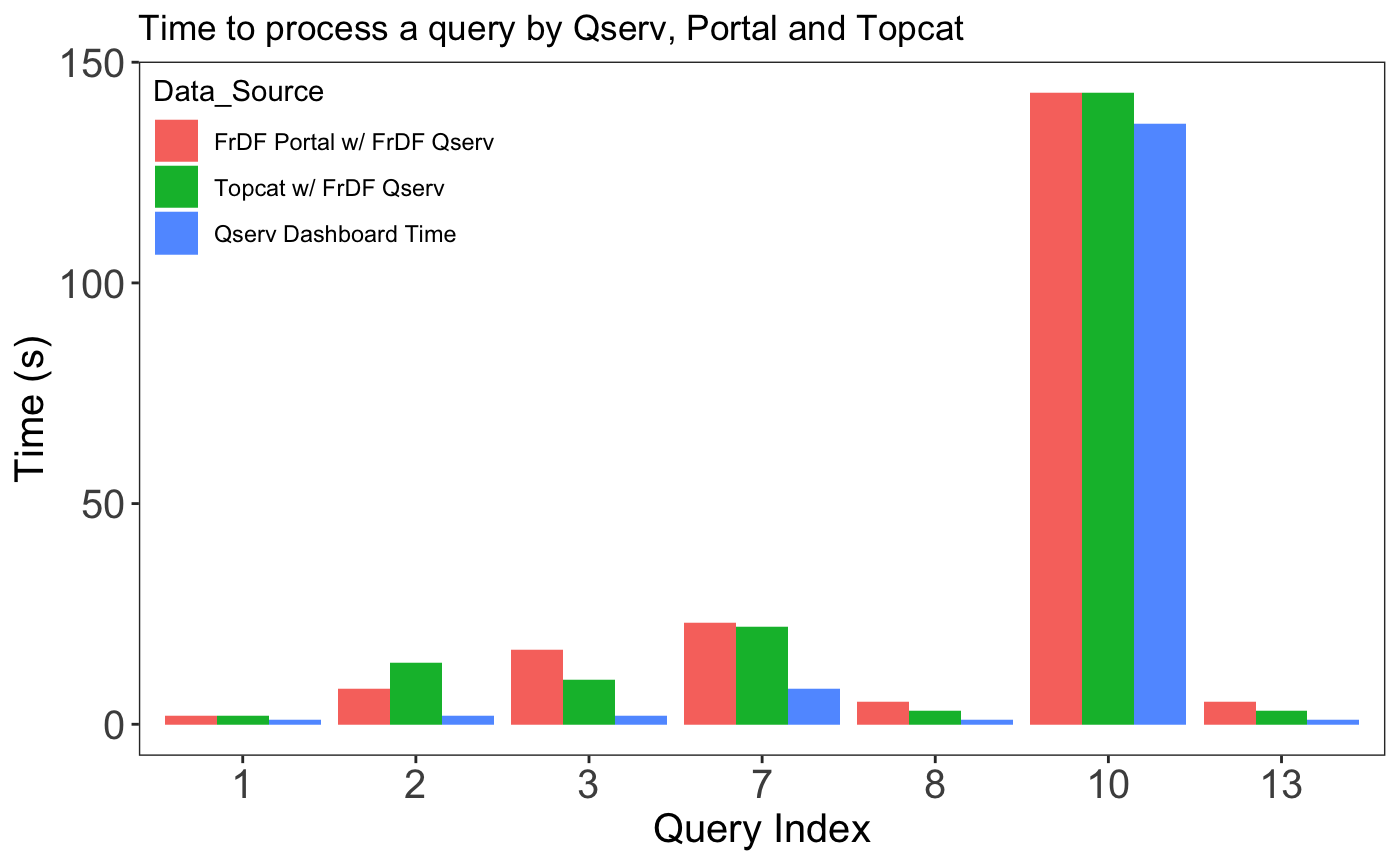DMTN-298
Using UKDF Qserv instance as FrDF Rubin Science Platform TAP service backend#
Abstract
In this note, we describe the procedure to set up a Qserv instance hosted remotely as the backend for the Rubin Science Platform (RSP) TAP service hosted at CC-IN2P3. We also present some tests conducted to evaluate the impact on performance linked to this configuration.
Introduction#
The Rubin Science Platform (RSP) is a set of web applications providing easy access to Rubin data for interactive analysis. Access to the data is mainly provided by an IVOA Table Access Protocol [1], which provides an interface between the user and the backend catalog database.
The catalog database, in general, is stored on a Qserv instance [2]. The FrDF RSP currently uses its own Qserv instance, which is deployed on a Kubernetes cluster hosted on local bare-metal machines, and provides access to 4 catalogs with a total of 55TB of data.
We are exploring the possibility to use a Qserv instance deployed outside the CC-IN2P3 as backend for the FrDF RSP TAP service.
RSP TAP configuration for Qserv access#
In this section we descrive how to configure TAP in Phalanx to use a Qserv instance.
Phalanx TAP configuration#
The TAP RSP service can be easily configured to point to a Qserv instance via:
qserv:
host: "hostname:port"
But this configuration is not enough to make the TAP service able to talk with Qserv. TAP also needs to know the Qserv databases’ schemas, and this information is provided via a Docker image built by the Qserv admins (who know what Qserv serves) and provided to the TAP service via the following configuration:
cadc-tap:
tapSchema:
image:
repository: "image"
tag: x.y.z
In thiw way, we the right settings, we can then setup an RSP TAP service to talk with any Qserv instance.
TAP Configuration at FrDF#
The FrDF RSP is configured to use the FrDF Qserv instance in TAP.
The configuraton is described in the next block of code:
cadc-tap:
tapSchema:
image:
repository: "gabrimaine/tap-schema-ccin2p3"
tag: 2.4.1
config:
qserv:
host: "ccqserv201.in2p3.fr:30040"
The configuration point to the FrDF Qserv instance and use as TAP schema image the image tap-schema-ccin2p3 providing the DB schema for all the catalogs ingested in the FrDF Qserv.
For our test, we wanted check the configuration and the performance of the TAP service using a remote Qserv instance. For this, we set up the TAP service to point to the UKDF Qserv. This implied a change in the Phalanx configuration but also a change in the UKDF firewall to provide access to the UKDF Qserv from FrDF RSP IPs.
Once the problem with the firewall was fixed, the FrDF RSP TAP configuration was changed to:
cadc-tap:
tapSchema:
image:
repository: "stvoutsin/tap-schema-roe"
config:
qserv:
host: "192.41.122.85:30040"
Performance test#
The main objective was to test the impact on query performance using a remote Qserv instance instead of the local Qserv instance. This has been done by performing a set of queries on FrDF RSP using both Qserv instances (FrDF and UKDF) as the backend
The queries used are listed in the following table.
Query Index |
Query |
|---|---|
1 |
|
|
|
2 |
|
|
|
|
|
3 |
|
4 |
|
|
|
5 |
|
|
|
6 |
|
|
|
7 |
|
|
|
8 |
|
|
|
|
|
9 |
|
|
|
|
|
10 |
|
|
|
|
|
|
|
|
|
|
|
11 |
|
12 |
|
|
|
13 |
|
|
|
|
|
14 |
# Catalog Queries with the TAP Service notebook |
The query number 14 listed above is not a single query, but it consists of running a full notebook provided for the DP0.2 test in RSP Nublado.
The queries against TAP service have been performed in different ways
Using the RSP Portal ADQL interface
Using an external service (Topcat) via token provided by the RSP
Using an RSP Nublado notebook for query 14 as described above.
We also tested the same queries on USDF and IDF RSP (only via ADQL Portal interface).
Results#
The following table reports the results (in seconds) for the tested requests. Not all the queries have been tested with Topcat and they are marked as NP. The table’s columns are the following:
Query Index is the identifier of the query as listed in the table above.
# Sources is the number of sources retrieved by the query
Qserv Chunks is the number of Qserv chunks scanned by the query
Qserv Time is the time needed by Qserv to execute the query as reported by the Qserv dashboard
FrDF via Portal is the time measured by the Portal to perform the query
FrDF via TOPCAT is the time needed to perform the query via Topcat
FrDF w/ UKDF Portal is the time measured by the Portal to perform the query when the FrDF RSP is plugged on UKDF Qserv
FrDF w/ UKDF Topcat is the time needed to perform the query via FrDF API Topcat when the FrDF RSP is plugged on UKDF Qserv
IDF/USDF/UKDF is the time to perform the query via Portal on IDF/USDF/UKDF RSP instances
Query Index |
# Sources |
Qserv Chunks |
Qserv Time |
FrDF |
FrDF |
FrDF w/ UKDF |
FrDF w/ UKDF |
IDF |
USDF |
UKDF |
|---|---|---|---|---|---|---|---|---|---|---|
1 |
15 |
1 |
1 |
2 |
2 |
3 |
3 |
2 |
1 |
4 |
2 |
50000 |
6 |
2 |
8 |
14 |
9 |
7 |
6 |
5 |
8 |
3 |
1519 |
1 |
2 |
17 |
10 |
18 |
11 |
17 |
8 |
14 |
4 |
200000 |
19 |
6 |
11 |
NP |
10 |
NP |
11 |
5 |
7 |
5 |
200000 |
19 |
5 |
13 |
NP |
11 |
NP |
9 |
8 |
10 |
6 |
200000 |
19 |
5 |
11 |
NP |
12 |
NP |
12 |
7 |
10 |
7 |
500000 |
19 |
8 |
23 |
22 |
24 |
25 |
18 |
12 |
18 |
8 |
12 |
11 |
1 |
5 |
3 |
3 |
4 |
3 |
1 |
3 |
9 |
432 |
1 |
6 |
9 |
NP |
9 |
NP |
3 |
2 |
18 |
10 |
14501 |
2 |
136 |
143 |
143 |
159 |
149 |
147 |
84 |
149 |
11 |
1 |
1 |
1 |
2 |
NP |
2 |
NP |
2 |
1 |
4 |
12 |
500000 |
1393 |
27 |
71 |
NP |
79 |
NP |
482 |
13 |
39 |
13 |
41751 |
19 |
1 |
5 |
3 |
5 |
5 |
16 |
6 |
4 |
14 |
NA |
NA |
NA |
80 |
NA |
78 |
NA |
210 |
48 |
NA |
Queries via Portal#
The next plot shows the results for queries executed using the ADQL interface directly from the RSP Portal service. The queries have been performed via three RSP instances: IDF, USDF, and FrDF. FrDF instances have been configured with FrDF Qserv and UKDF Qserv as backend.

Fig. 1 ADQL Queries via TAP Portal interface for IDF, USDF, and FrDF instances. FrDF RSP configured with FrDF and UKDF Qserv backend.#
We note a generally better performance of USDF RSP, but for the other RSP instances, there are no significant differences (if we exclude query 12, which seems to have some issues with IDF, and for which we removed the IDF values to make the plot easier to read).

Fig. 2 ADQL Queries via TAP Portal interface for IDF, USDF, and FrDF instances. FrDF RSP configured with FrDF and UKDF Qserv backend. Query #12 removed to improve readability.#
For the scope of our exercise, the results do not show a loss in performance when moving from FrDF Qserv to UKDF Qserv, nor do they indicate a significant impact from network latency on queries. The time for each query is consistent between FrDF and UKDF Qserv.
These results seem to confirm that using UKDF Qserv as the FrDF RSP backend is a viable option. However, there are still some uncertainties about the load on the UKDF Qserv: specifically, how the impact of UKDF users can affect the RSP performance at FrDF and vice versa. This point is currently not measurable and requires further study.
Queries via Topcat#
Results for the two FrDF configurations are confirmed also using TAP service for Topcat [3] queries.

Fig. 3 ADQL Queries via Topcat using TAP service provided by FrDF RSP configured with FrDF and UKDF Qserv backend.#
The time needed to process a query is almost the same whether the RSP backend is set to point to the FrDF Qserv instance or the UKDF Qserv instance.
Queries processing#
We noted, however, an impact not due to the Qserv backend but probably due to the ‘post-processing’ of results by the Portal (and Topcat), affecting the time necessary to display them. Comparing the query time as measured at the level of Qserv and the time measured at the level of the Portal, we sometimes see a noticeable discrepancy, as shown in the next figure.

Fig. 4 Time to process a query at the level of Qserv (as reported by the Qserv dashboard) and at the level of the Portal.#
Topcat is also affected by this ‘post-processing’ issue but seems a little less impacted than Portal.
Conclusions#
The scope of the test was checking the impact on performance for our RSP (FrDF RSP) when a remote Qserv instance (UKDF) is used as the backend for the TAP service. The first preliminary test seems to exclude a large impact on performance due to, e.g., network latency, load on Qserv, etc. However, we cannot exclude an impact on this aspect when the load on the UKDF Qserv increases. The performance is in line using Portal and Topcat TAP services, but we noted a delay in results showing, probably due to ‘post-processing’ steps needed by Portal and Topcat to organize the retrieved catalogs.
Further tests are needed to verify these results with a set of more articulated and ‘science representative’ queries, but for the moment we can confirm the possibility of using a remote Qserv instance as an RSP backend.